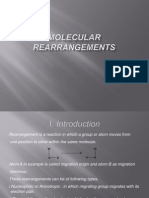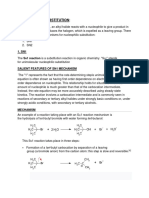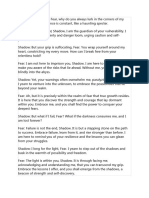0 ratings0% found this document useful (0 votes)
478 viewsDipole Moment
Dipole Moment
Uploaded by
LATHA JANARTHANANThe document discusses dipole moments, which arise due to a separation of positive and negative charges in a molecule. A dipole moment is a measure of the polarity of a chemical bond. It is a vector quantity that depends on the magnitude of the charges and the distance between them. In a polyatomic molecule, the overall dipole moment is calculated as the vector sum of the individual bond dipole moments.
Copyright:
© All Rights Reserved
Available Formats
Download as PPTX, PDF, TXT or read online from Scribd
Dipole Moment
Dipole Moment
Uploaded by
LATHA JANARTHANAN0 ratings0% found this document useful (0 votes)
478 views11 pagesThe document discusses dipole moments, which arise due to a separation of positive and negative charges in a molecule. A dipole moment is a measure of the polarity of a chemical bond. It is a vector quantity that depends on the magnitude of the charges and the distance between them. In a polyatomic molecule, the overall dipole moment is calculated as the vector sum of the individual bond dipole moments.
Copyright
© © All Rights Reserved
Available Formats
PPTX, PDF, TXT or read online from Scribd
Share this document
Did you find this document useful?
Is this content inappropriate?
The document discusses dipole moments, which arise due to a separation of positive and negative charges in a molecule. A dipole moment is a measure of the polarity of a chemical bond. It is a vector quantity that depends on the magnitude of the charges and the distance between them. In a polyatomic molecule, the overall dipole moment is calculated as the vector sum of the individual bond dipole moments.
Copyright:
© All Rights Reserved
Available Formats
Download as PPTX, PDF, TXT or read online from Scribd
Download as pptx, pdf, or txt
0 ratings0% found this document useful (0 votes)
478 views11 pagesDipole Moment
Dipole Moment
Uploaded by
LATHA JANARTHANANThe document discusses dipole moments, which arise due to a separation of positive and negative charges in a molecule. A dipole moment is a measure of the polarity of a chemical bond. It is a vector quantity that depends on the magnitude of the charges and the distance between them. In a polyatomic molecule, the overall dipole moment is calculated as the vector sum of the individual bond dipole moments.
Copyright:
© All Rights Reserved
Available Formats
Download as PPTX, PDF, TXT or read online from Scribd
Download as pptx, pdf, or txt
You are on page 1of 11
DIPOLE MOMENT
• A dipole moment arises in any system in which
there is a separation of charge. They can,
therefore, arise in ionic bonds as well as in
covalent bonds.
• Dipole moments occur due to the difference
in electronegativity between two chemically
bonded atoms.
DIPOLE MOMENT
• A bond dipole moment is a measure of the
polarity of a chemical bond between two
atoms in a molecule. It involves the concept of
electric dipole moment, which is a measure of
the separation of negative and positive
charges in a system.
DIPOLE MOMENT
• The bond dipole moment is a vector quantity
since it has both magnitude and direction. An
illustration describing the dipole moment that
arises in an HCl molecule is provided below.
DIPOLE MOMENT
• It can be noted that the symbols 𝛿+ and
𝛿– represent the two electric charges that
arise in a molecule which are equal in
magnitude but are of opposite signs. They are
separated by a set distance, which is
commonly denoted by ‘d’.
IMPORTANT POINTS
• The dipole moment of a single bond in a polyatomic molecule is known as the
bond dipole moment and it is different from the dipole moment of the
molecule as a whole.
• It is a vector quantity, i.e. it has magnitude as well as definite directions.
• Being a vector quantity, it can also be zero as the two oppositely acting bond
dipoles can cancel each other.
• By convention, it is denoted by a small arrow with its tail on the negative
center and its head on the positive center.
• In chemistry, the dipole moment is represented by a slight variation of the
arrow symbol. It is denoted by a cross on the positive center and arrowhead
on the negative center. This arrow symbolizes the shift of electron density in
the molecule.
• In the case of a polyatomic molecule, the dipole moment of the molecule is
the vector sum of the all present bond dipoles in the molecule.
MATHEMATICAL EXPRESSION
• A dipole moment is the product of the magnitude of the
charge and the distance between the centers of the positive
and negative charges. It is denoted by the Greek letter ‘µ’.
• Mathematically,
• Dipole Moment (µ) = Charge (Q) * distance of separation (r)
• It is measured in Debye units denoted by ‘D’. 1 D = 3.33564 ×
10-30 C.m, where C is Coulomb and m denotes a meter.
• The bond dipole moment that arises in a chemical bond
between two atoms of different electronegativities can be
expressed as follows:
• μ = 𝛿.d
Dipole moment of BeF2
• In a beryllium fluoride molecule, the bond angle between the
two beryllium-fluorine bonds is 180o. Fluorine, being the more
electronegative atom, shifts the electron density towards
itself. The individual bond dipole moments in a BeF2 molecule
are illustrated below.
BORON TRIFLUORIDE
POLYATOMIC MOLECULE
WATER MOLECULE
You might also like
- Kelvin Equation - A ReviewDocument12 pagesKelvin Equation - A ReviewKonkmanNo ratings yet
- TYBSc Electrochemistry March14 PDFDocument12 pagesTYBSc Electrochemistry March14 PDFshunmugamNo ratings yet
- HMBC and HMQCDocument13 pagesHMBC and HMQCArthur Girardi CarpanezNo ratings yet
- ElectronegativityDocument17 pagesElectronegativityCat123No ratings yet
- Solid State Chemistry - EPMDocument8 pagesSolid State Chemistry - EPMjahidul islamNo ratings yet
- ATOOCV1!3!11 Generation Structure Stability and Reactivity of Carbocations Carbanions Free Radicals Carbenes and NitrenesDocument32 pagesATOOCV1!3!11 Generation Structure Stability and Reactivity of Carbocations Carbanions Free Radicals Carbenes and NitrenesUgan KumarNo ratings yet
- Standard Hydrogen ElectrodeDocument2 pagesStandard Hydrogen ElectrodeAmmara Amy100% (1)
- Sigmatropic Rearrangement ReactionDocument18 pagesSigmatropic Rearrangement ReactionSuman ChauhanNo ratings yet
- Electrochemistry Lecture 2 - NotesDocument17 pagesElectrochemistry Lecture 2 - NotesCraftychemistNo ratings yet
- Class 11 Chemistry Revision Notes Chemical Bonding and Molecular StructureDocument26 pagesClass 11 Chemistry Revision Notes Chemical Bonding and Molecular Structureshusa harshaNo ratings yet
- Dipole MomentDocument12 pagesDipole MomentSujalNo ratings yet
- Chemistry PPT Project VSPER THEORYDocument8 pagesChemistry PPT Project VSPER THEORYAini RizviNo ratings yet
- Elimination Reaction PDFDocument4 pagesElimination Reaction PDFshantharm100% (3)
- Electroanalytical ChemistryDocument4 pagesElectroanalytical ChemistrybelleNo ratings yet
- Vander Vaal ForcesDocument132 pagesVander Vaal Forcesmanisha maniNo ratings yet
- Irreversible Thermodynamics For Membrane TransportDocument9 pagesIrreversible Thermodynamics For Membrane TransportDBS AuthorityNo ratings yet
- Galvanic Cell With No Cation FlowDocument7 pagesGalvanic Cell With No Cation FlowsiswoutNo ratings yet
- Hard SoftDocument24 pagesHard SoftMuhammad FahmiNo ratings yet
- Introduction To Inorganic PhotochemistrypdfDocument6 pagesIntroduction To Inorganic Photochemistrypdfjayaprabha KNNo ratings yet
- Elimination Reactions Mechanism Lecture NotesDocument17 pagesElimination Reactions Mechanism Lecture NotesveluselvamaniNo ratings yet
- Langevin of DiamagnetismDocument6 pagesLangevin of Diamagnetismlakshmi2811No ratings yet
- Molecular RearrangementsDocument158 pagesMolecular RearrangementsRamesh Katkam75% (4)
- Chain Reactions: Complex Rate ExpressionsDocument10 pagesChain Reactions: Complex Rate ExpressionsGreeshma Gireesh0% (1)
- Elimination ReactionDocument40 pagesElimination ReactionAnkit AnandNo ratings yet
- PolarizabilityDocument9 pagesPolarizabilityFabioNo ratings yet
- Unit 3 Potentiometry-II (PH Metry)Document24 pagesUnit 3 Potentiometry-II (PH Metry)Nathanian100% (1)
- Molecular Orbital TheoryDocument28 pagesMolecular Orbital TheoryYen Yen YapNo ratings yet
- CHEMISTRY (XI, XII & Medical) by VIJAY KUMAR (M.Sc. B.Ed.)Document10 pagesCHEMISTRY (XI, XII & Medical) by VIJAY KUMAR (M.Sc. B.Ed.)Vijay KumarNo ratings yet
- Enzyme and Acid - Base CatalysisDocument64 pagesEnzyme and Acid - Base Catalysisbinseung skzNo ratings yet
- Electronic SpectraDocument22 pagesElectronic SpectraVishnu ChariNo ratings yet
- ATOOCV1 7 0 Aliphatic Electrophilic SubstitutionDocument18 pagesATOOCV1 7 0 Aliphatic Electrophilic SubstitutionVel SankarNo ratings yet
- Statistical ThermodynamicsDocument16 pagesStatistical Thermodynamicsbits_who_am_i100% (1)
- ATOICV1 8 9 Charge Transfer Spectra NawazDocument16 pagesATOICV1 8 9 Charge Transfer Spectra Nawazsaira mehmoodNo ratings yet
- Electrokinetic Phenomenon FinalDocument12 pagesElectrokinetic Phenomenon FinalRithika Prasad SaniNo ratings yet
- Aldol Reaction - Addition - Condensation - Mechanism - AdichemistryDocument7 pagesAldol Reaction - Addition - Condensation - Mechanism - AdichemistryBiswa Bhusan NayakNo ratings yet
- Chemical Bonding A PDFDocument22 pagesChemical Bonding A PDFshubhammukriNo ratings yet
- Group Theory (Theory) - Inorganic Chemistry Virtual Lab - Chemical SciencesDocument16 pagesGroup Theory (Theory) - Inorganic Chemistry Virtual Lab - Chemical SciencesNicholas ThompsonNo ratings yet
- Vibration-Rotation Spectroscopy of HCL and DCLDocument14 pagesVibration-Rotation Spectroscopy of HCL and DCLLovely yadavNo ratings yet
- Molecular Term SymbolsDocument5 pagesMolecular Term Symbols1jerushaNo ratings yet
- PolarizabilityDocument8 pagesPolarizabilitygone4328No ratings yet
- Pericyclic Reactions - I by K.N.S.swamI - pdf475Document52 pagesPericyclic Reactions - I by K.N.S.swamI - pdf475suganya 1995No ratings yet
- Aromaticity NotesDocument6 pagesAromaticity NotesSLIMBOI OpNo ratings yet
- LCAO MO Theory Illustrated by Its Application To H2Document8 pagesLCAO MO Theory Illustrated by Its Application To H2maugonzalezsuarezNo ratings yet
- Photoelectron SpectroscopyDocument41 pagesPhotoelectron SpectroscopyEbsiba Beaula JNo ratings yet
- Point Defects in SolidsDocument37 pagesPoint Defects in SolidsSachi SinghNo ratings yet
- Nucleophilic Substitution Reactions (SN1, SN2) AND Elimination Reactions (E1, E2)Document11 pagesNucleophilic Substitution Reactions (SN1, SN2) AND Elimination Reactions (E1, E2)Makhdoom JahaniaNo ratings yet
- Carbocations 2Document16 pagesCarbocations 2Surabhi BansalNo ratings yet
- Abbe RefractometerDocument9 pagesAbbe RefractometergiorgyaNo ratings yet
- The D and F Block Elements-Anil-HssliveDocument8 pagesThe D and F Block Elements-Anil-HssliveRanit MukherjeeNo ratings yet
- Lecture 8 Colloids Electrokinetic PhenomenonDocument33 pagesLecture 8 Colloids Electrokinetic PhenomenonJunaid Parker0% (1)
- The Steady State Approximation Is A Method Used To Estimate The Overall Reaction Rate of A MultiDocument6 pagesThe Steady State Approximation Is A Method Used To Estimate The Overall Reaction Rate of A MultiMubashar ShakeelNo ratings yet
- Periodic Properties - Part 1Document30 pagesPeriodic Properties - Part 1Bhavesh GargNo ratings yet
- V B TDocument12 pagesV B TAshish KatariaNo ratings yet
- Theories of Catalysis. PresentationDocument19 pagesTheories of Catalysis. PresentationAqSaNo ratings yet
- Pericyclic Reactions, 1Document7 pagesPericyclic Reactions, 1Aparna SahaNo ratings yet
- Aromatic Electrophillic - IIDocument15 pagesAromatic Electrophillic - IInananana100% (2)
- Lec 7 Dipole MomentDocument3 pagesLec 7 Dipole MomentMuhammad Farid ShahidNo ratings yet
- A Dipole Moment Arises in Any System in Which There Is A Separation of ChargeDocument5 pagesA Dipole Moment Arises in Any System in Which There Is A Separation of ChargehuesosNo ratings yet
- Dipole MomentDocument2 pagesDipole Momentkheemrajgarg4No ratings yet
- Chapter 3 Determining PolarityDocument39 pagesChapter 3 Determining Polarityjiptekaye.leberoNo ratings yet
- Fear 2Document3 pagesFear 2LATHA JANARTHANANNo ratings yet
- Preparation of Chlorine: 4nacl + Mno + 4H So MNCL + 4nahso + 2H O + CLDocument10 pagesPreparation of Chlorine: 4nacl + Mno + 4H So MNCL + 4nahso + 2H O + CLLATHA JANARTHANANNo ratings yet
- BRAVERYDocument2 pagesBRAVERYLATHA JANARTHANANNo ratings yet
- BatteriesDocument20 pagesBatteriesLATHA JANARTHANANNo ratings yet
- Mole ConceptDocument23 pagesMole ConceptLATHA JANARTHANANNo ratings yet
- Nitric AcidDocument21 pagesNitric AcidLATHA JANARTHANANNo ratings yet
- Properties of HydrogenDocument9 pagesProperties of HydrogenLATHA JANARTHANANNo ratings yet
- Aisling McCluskey, Brian McMaster - Undergraduate Analysis - A Working Textbook-Oxford University Press (2018)Document398 pagesAisling McCluskey, Brian McMaster - Undergraduate Analysis - A Working Textbook-Oxford University Press (2018)currecurreNo ratings yet
- Villa B 3 BHKDocument1 pageVilla B 3 BHKVipin chandraNo ratings yet
- Extending The Lifetime and Balancing Energy Consumption in Wireless Sensor NetworksDocument9 pagesExtending The Lifetime and Balancing Energy Consumption in Wireless Sensor NetworksNaresh KumarNo ratings yet
- 101.8 Low Alloy Steels (Disk and Rod Forms)Document1 page101.8 Low Alloy Steels (Disk and Rod Forms)SergioNo ratings yet
- FX 250/FX 500 User ManualDocument121 pagesFX 250/FX 500 User ManualdianrahmathidayatNo ratings yet
- English10 q1 Mod7 Makingjudgementsaboutrangeoftexts FinalDocument24 pagesEnglish10 q1 Mod7 Makingjudgementsaboutrangeoftexts FinalCyrel Loto OdtohanNo ratings yet
- Lesson 2 The Concept of Logic CircuitsDocument23 pagesLesson 2 The Concept of Logic CircuitsAsh LeyNo ratings yet
- BTechIT 2018-19Document244 pagesBTechIT 2018-19Sajal KhatriNo ratings yet
- Worksheet On Obstruction and AsthmaDocument14 pagesWorksheet On Obstruction and AsthmaKaye CorNo ratings yet
- EIA Oxidation Pond JUDocument71 pagesEIA Oxidation Pond JUnot now100% (1)
- Supersci-Chemistry of Invisible InksDocument2 pagesSupersci-Chemistry of Invisible InksHasanzubyreNo ratings yet
- Stainless Steel - Wikipedia, The Free EncyclopediaDocument7 pagesStainless Steel - Wikipedia, The Free EncyclopediaTuan DoNo ratings yet
- NATA Aptitude Section - Mock Test 1 Student Name: Center Name: Total Marks: 80 Total Time: 50 Mins Question and Answer OptionsDocument8 pagesNATA Aptitude Section - Mock Test 1 Student Name: Center Name: Total Marks: 80 Total Time: 50 Mins Question and Answer OptionsKarthik SrinivasNo ratings yet
- D&D 3.5 Web - Adventure LocalesDocument43 pagesD&D 3.5 Web - Adventure LocalestamerzNo ratings yet
- Praying As Agents - Notes - Elder Brian L RawsonDocument4 pagesPraying As Agents - Notes - Elder Brian L Rawsonhunter100% (1)
- Annex 2-REGISTRY OF BUDGET, COMMITMENTS, PAYMENTS AND BALANCESDocument7 pagesAnnex 2-REGISTRY OF BUDGET, COMMITMENTS, PAYMENTS AND BALANCESVermon JayNo ratings yet
- MC-10207815-0001 MdpsDocument21 pagesMC-10207815-0001 Mdpsjohndere2090No ratings yet
- BRMS BackupDocument134 pagesBRMS Backupprashanth100% (1)
- NutriNest Case Study (1)Document10 pagesNutriNest Case Study (1)hieudz4112No ratings yet
- Srbija I Branicevo U Velikom Ratu WebDocument312 pagesSrbija I Branicevo U Velikom Ratu WebStefan Stankovic100% (1)
- Contact Center Vendor Comparison Matrix (3)Document3 pagesContact Center Vendor Comparison Matrix (3)subzzNo ratings yet
- Cisco ASR 9000 Series 24-Port 10 Gigabit Ethernet Line CardsDocument6 pagesCisco ASR 9000 Series 24-Port 10 Gigabit Ethernet Line CardsfuckyouscribdNo ratings yet
- Chapter 2Document33 pagesChapter 2Tam DoNo ratings yet
- Joseph Bejogan - September 2021: 1. Introduction To AnatomyDocument2 pagesJoseph Bejogan - September 2021: 1. Introduction To AnatomyCarren SabioNo ratings yet
- Modal Verbs For Suggestion and AdviceDocument4 pagesModal Verbs For Suggestion and AdvicePrada NaNo ratings yet
- Her (Film) : 1 PlotDocument7 pagesHer (Film) : 1 PlotevelynsilNo ratings yet
- Windows-1 Active Directory AdministratorDocument4 pagesWindows-1 Active Directory AdministratorPerfectKey21No ratings yet
- BDSA601 ITML603 The Literature Review (Copy)Document39 pagesBDSA601 ITML603 The Literature Review (Copy)calev28828No ratings yet
- (Template) MAJOR 8 4th Study Guide and Learning For MidTermDocument8 pages(Template) MAJOR 8 4th Study Guide and Learning For MidTermRene ChuaNo ratings yet
- Synopsis Sagar Project - A Study On The Need of CRM in OrganizatonDocument3 pagesSynopsis Sagar Project - A Study On The Need of CRM in OrganizatonViraja GuruNo ratings yet
































































































